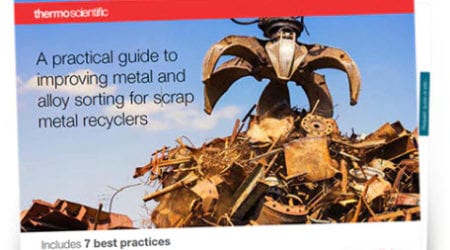 Handheld analyzers that utilize Laser Induced Breakdown Spectroscopy (LIBS) are used for material verification – especially on pipelines – and in other industries like metal fabrication and for positive material identification (PMI). Manufacturers use LIBS handheld analyzers to:
Handheld analyzers that utilize Laser Induced Breakdown Spectroscopy (LIBS) are used for material verification – especially on pipelines – and in other industries like metal fabrication and for positive material identification (PMI). Manufacturers use LIBS handheld analyzers to:
- Identify low alloy/ carbon steels and L and H grade steels
- Determine alloy composition and grade for a wide range of metallurgical samples
- Calculate carbon equivalency to determine piping weldability
- Verify critical assets, such as, piping, valves and reaction vessels
- Inspect materials at receiving, in-process fabrication and outgoing Quality Control (QC)
- Qualify Material Test Reports (MTR)
- Prevent contaminated scrap from entering the supply stream
- Detect tramp and trace elements to meet regulatory standards
Safety precautions must be taken, however, whenever using a LIBS analyzer. LIBS technology uses a tightly focused laser to ablate the surface of a sample to form a plasma. The plasma, which then atomizes and excites the sample, emits light that is transmitted through fiber optics and enters the spectrometer through a slit. The light then interacts with a diffraction grating and splits the light into its component wavelengths. The detector produces a spectrum from the sample which can be analyzed, and the concentration of each element determined. The instrument, including the laser, can pose a danger if not used properly, so precautions should be taken.
CAUTION: These are just examples of precautions to be taken when using a Thermo Scientific™ Niton™ Apollo™ Handheld LIBS Analyzer. Anyone using any laser technology should follow instructions and take full training from the manufacturer before operating the instrument.
There are four topics of safety that should be addressed when using a LIBS analyzer:
- Laser safety
- Instrument safety
- Battery safety
- Safe Handling of Argon Cartridges
Laser Safety
A typical laser used in these types of handheld instruments are Class 3B, that operate at a wavelength of 1064 nanometers, which means the beam is completely invisible to our eyes. If used inappropriately the analyzer can cause damage to eyes or skin. The user must be within a certain distance from the beam (otherwise known as the Nominal Ocular Hazard Distance -NOHD-), never look directly into the beam, and be aware of any reflective surfaces that may affect the beam. In addition, the analyzers are NOT designed to be intrinsically safe, so they should not be operated with any explosive, ignitable, or unknown samples and operated in controlled air environments.
Engineering Controls
Engineering controls, including robust safety interlocks, help to create a safe environment for laser use. These engineering controls include a pressurized seal that is continuously measured during analysis, a micro camera that measures the amount of light entering the front end of the analyzer, and an automatic disengagement if the spectrum is non-standard.
Administrative Controls
Administrative controls are utilized to help change the way people work. Laser indicator lights should alert the operator and others in the area when the laser is on, a caution symbol should be shown when the trigger is active and remain on the screen when the laser is firing, and a secondary, audible laser or warning indicator (such as a beep) when a measurement is initiated and the laser turns on. People should be trained to never aim the analyzer at oneself or others, and never pull the trigger unless there is an appropriate sample fully covering the laser aperture.
Personal Protective Equipment
It is recommended for operators to wear laser safety eyewear when operating the analyzer. Be aware that certain laser safety eyewear is designed specifically for lasers with different wavelengths and different output power. Therefore, other safety eyewear that may work with other lasers or instruments may not be appropriate for the instrument being used. Eyewear must be rated optical density (OD) 5 or greater at 1064 nm. Only eyewear printed with this specification will be appropriate eye protection for the laser. Additionally, ensure that laser safety eyewear is immediately replaced if ever deeply scratched or damaged in any way that would allow the laser light to expose the eyes.
Instrument Safety & Regulations
There are no user serviceable parts. Any attempt to disassemble the analyzer will lead to unnecessary safety risk. Always follow the safe practices outlined in the manufacturer’s user’s guide. For regulations and safety regarding use of lasers, be sure to contact the state you are operating under. Most regulated states adopt the American National Standard for Safe Use of Lasers (ANSI Z136.1).
Lithium-Ion Battery Safety
Most battery safety issues with lithium-ion batteries come about because of mishandling, especially from continuing to use damaged batteries. Follow safe handling and storage practices.
- Use only the batteries specified by the manufacturer.
- Do not disassemble, crush, puncture, shred, or change the form of your battery.
- Always remove the battery from the analyzer when you are not using it or when it is stored in its case.
- Do not use tools or other mechanical means to remove the battery from the analyzer; doing so can damage the battery.
- Do not immerse the battery in water or allow the battery terminals to come into contact with liquids.
- Never transport the analyzer with the battery pack connected to the analyzer.
- Do not store spare batteries where their terminals could come in contact with other metal items. Do not store batteries near flammable materials.
- Do not leave batteries near a high heat source, in direct sunlight, or in cars in extremely hot weather.
- Dispose of used batteries in compliance with local regulations. Do not dispose of used batteries in the trash, and do not incinerate used batteries.
- If your battery is damaged, contact the manufacturer.
Safe Handling of Argon Cartridges
Although argon is neither flammable nor reactive, the cartridges can explode in the heat of a fire because of the increased internal pressure.
- Do not puncture cartridges. Avoid dropping or striking a cartridge.
- Store argon cartridges away from materials or conditions that present hazards to each other.
- Do not store argon cartridges in your vehicle because of the possibility of high temperatures.
- Do not dispose of empty argon cartridges in the trash.
- If argon gas leaks from the cartridge, the gas will quickly dissipate in the atmosphere, thus leading to no harmful health effects. Do not intentionally inhale the gas.
- Cartridges may not be refilled but can be recycled with local authorities. Recycled cartridges must be labelled “EMPTY”, otherwise they will not be accepted.
Summary
Be aware of the hazards associated with lasers, and specifically from a LIBS instrument, to avoid injury. Take the appropriate precautions and training, and follow the manufacturer’s instructions for safe handling and use of this excellent tool for quantitative and qualitative measurements.
To learn more, visit our Niton Apollo and LIBS page.
If you are a Thermo Fisher Scientific customer, you may access free online LIBS training courses here:
LIBS Safety Training information.
Additional Resources:
- Download our free eBook: A Practical Guide to Improving Steel Manufacturing Processes and Production Methods
- Visit our center for Improving Steel Manufacturing Processes and Production




Leave a Reply